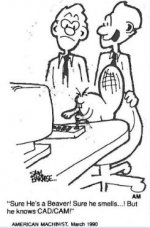Whetstone
Cast Iron
- Joined
- Mar 27, 2011
- Location
- Providence RI
We've been having a lot of issues at our shop with our current CAD designer. They have ok skills, but are not interested in learning and more importantly - they are not really invested in their job (tardiness, not taking responsibility for mistakes, general poor attitude). I have started a search for a new CAD designer, but I would like to know how other people evaluate potential CAD hires. Beyond choosing a better fit attitude-wise, I would also like to hire someone that does a better job than our current person.
The main issue we run into with CAD designers is that they lack the perspective of someone who actually makes/fabricates. It's not unusual to get drawings that can't actually be made into a real object. Another difficulty is that our shop does not produce any single product. We specialize in custom architectural and sculptural installations. So we use a variety of metals that come in all shapes and sizes, and the aesthetic requirements that we need to meet are exceptionally high. This is a challenging environment in many respects, but in some ways it's less intense than doing CAD for a product with 500 parts. Most CAD engineers that send me their resume, make widgets or specialize in a single industry.
How do you evaluate your CAD employees for aptitude? What type of hourly rate or salary are you offering for a CAD employee?
The main issue we run into with CAD designers is that they lack the perspective of someone who actually makes/fabricates. It's not unusual to get drawings that can't actually be made into a real object. Another difficulty is that our shop does not produce any single product. We specialize in custom architectural and sculptural installations. So we use a variety of metals that come in all shapes and sizes, and the aesthetic requirements that we need to meet are exceptionally high. This is a challenging environment in many respects, but in some ways it's less intense than doing CAD for a product with 500 parts. Most CAD engineers that send me their resume, make widgets or specialize in a single industry.
How do you evaluate your CAD employees for aptitude? What type of hourly rate or salary are you offering for a CAD employee?



